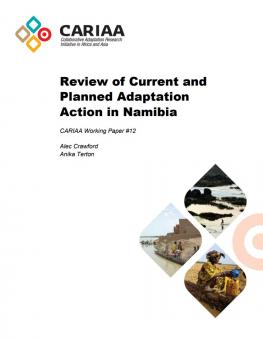
Review of Current and Planned Adaptation Action in Namibia
This report summarizes the climate risks and vulnerable sectors in Namibia, and examines the country’s efforts to implement climate change adaptation policies and initiatives at the national and sub-national levels.
Climate change presents a very real challenge to Namibia’s continued development progress.
As discussed in this review of its efforts to adapt to climate change, population growth, severe inequality and development trends will interact with changing rainfall patterns, rising temperatures, increased rates of evapotranspiration and rising sea levels to exacerbate water scarcity and other existing vulnerabilities. Despite these risks, Namibia is considered less vulnerable to the impacts of climate change than most of the countries of sub-Saharan Africa, which is more a function of its development status and sparse population than a reflection of its exposure to climate change or its policy environment. The government has identified six key sectors as particularly vulnerable: water and wetlands; agriculture; sea level rise, the coastal zone and fisheries; tourism; health; and disaster risk management. Climate change action has been prioritized by the government, which has passed a national climate change policy. However, momentum on the subject is strongly tied to donor interest and funding. Adaptation programs and projects currently underway in Namibia, as well as adaptation networks and communities of practice, are limited. This report provides an overview of these issues. It is one in a series of country reviews prepared by IISD to provide the Collaborative Adaptation Research Initiative in Africa and Asia (CARIAA) with a snapshot of adaptation action in its countries of engagement.
Participating experts
You might also be interested in
How to Make Nature-Based Solutions for Adaptation Work for Everyone
Effective nature-based solutions (NbS) for adaptation start with integrated climate risk assessments. These take-aways will help practitioners plan for inclusive and sustainable NbS.
Trends in Adaptation Planning: Observations from a recent stock-taking review
This brief provides an overview of observed trends in adaptation action that emerged from a standardized review of efforts in 15 African and Asian countries.
Review of Current and Planned Adaptation Action in Bangladesh
Review of Current and Planned Adaptation Action in India
This report summarizes the climate risks and vulnerable sectors in India, while providing an overview of policies and initiatives introduced at the national and sub-national levels to advance the country’s adaptation actions.